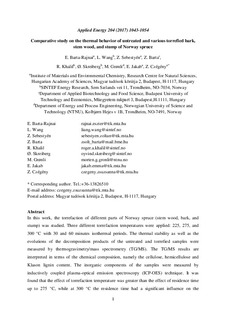| dc.contributor.author | Barta-Rajnai, Eszter | |
| dc.contributor.author | Wang, Liang | |
| dc.contributor.author | Sebestyén, Zoltán | |
| dc.contributor.author | Barta, Zsolt | |
| dc.contributor.author | Khalil, Roger Antoine | |
| dc.contributor.author | Skreiberg, Øyvind | |
| dc.contributor.author | Grønli, Morten | |
| dc.contributor.author | Jakab, Emma | |
| dc.contributor.author | Czégény, Zsuzsanna | |
| dc.date.accessioned | 2018-02-22T08:49:16Z | |
| dc.date.available | 2018-02-22T08:49:16Z | |
| dc.date.created | 2017-05-05T10:23:49Z | |
| dc.date.issued | 2017 | |
| dc.identifier.citation | Applied Energy. 2017, 204 1043-1054. | nb_NO |
| dc.identifier.issn | 0306-2619 | |
| dc.identifier.uri | http://hdl.handle.net/11250/2486321 | |
| dc.description.abstract | In this work, the torrefaction of different parts of Norway spruce (stem wood, bark, and stump) was studied. Three different torrefaction temperatures were applied: 225, 275, and 300 °C with 30 and 60 min isothermal periods. The thermal stability as well as the evolutions of the decomposition products of the untreated and torrefied samples were measured by thermogravimetry/mass spectrometry (TG/MS). The TG/MS results are interpreted in terms of the chemical composition, namely the cellulose, hemicellulose and Klason lignin content. The inorganic components of the samples were measured by inductively coupled plasma-optical emission spectroscopy (ICP-OES) technique. It was found that the effect of torrefaction temperature was greater than the effect of residence time up to 275 °C, while at 300 °C the residence time had a significant influence on the composition of the torrefied samples due to the intensive decomposition of cellulose. Principal component analysis has been applied to find statistical correlations between the torrefaction temperature, the residence time, the chemical composition and the thermal parameters of the samples. The results of the principal component analysis confirmed that the chemical composition and hence the thermal properties of the studied samples changed to a greater extent at higher torrefaction temperature than at lower torrefaction temperature. | nb_NO |
| dc.language.iso | eng | nb_NO |
| dc.publisher | Elsevier | nb_NO |
| dc.rights | Attribution-NonCommercial-NoDerivatives 4.0 Internasjonal | * |
| dc.rights.uri | http://creativecommons.org/licenses/by-nc-nd/4.0/deed.no | * |
| dc.title | Comparative study on the thermal behavior of untreated and various torrefied bark, stem wood, and stump of Norway spruce | nb_NO |
| dc.type | Journal article | nb_NO |
| dc.type | Peer reviewed | nb_NO |
| dc.description.version | acceptedVersion | nb_NO |
| dc.source.pagenumber | 1043-1054 | nb_NO |
| dc.source.volume | 204 | nb_NO |
| dc.source.journal | Applied Energy | nb_NO |
| dc.identifier.doi | 10.1016/j.apenergy.2017.05.057 | |
| dc.identifier.cristin | 1468330 | |
| dc.relation.project | Norges forskningsråd: 228726 | nb_NO |
| dc.relation.project | Norges forskningsråd: 244069 | nb_NO |
| dc.description.localcode | © 2017. This is the authors’ accepted and refereed manuscript to the article. Locked until 17.5.2019 due to copyright restrictions. This manuscript version is made available under the CC-BY-NC-ND 4.0 license http://creativecommons.org/licenses/by-nc-nd/4.0/ | nb_NO |
| cristin.unitcode | 194,64,25,0 | |
| cristin.unitname | Institutt for energi- og prosessteknikk | |
| cristin.ispublished | true | |
| cristin.fulltext | postprint | |
| cristin.qualitycode | 1 | |

